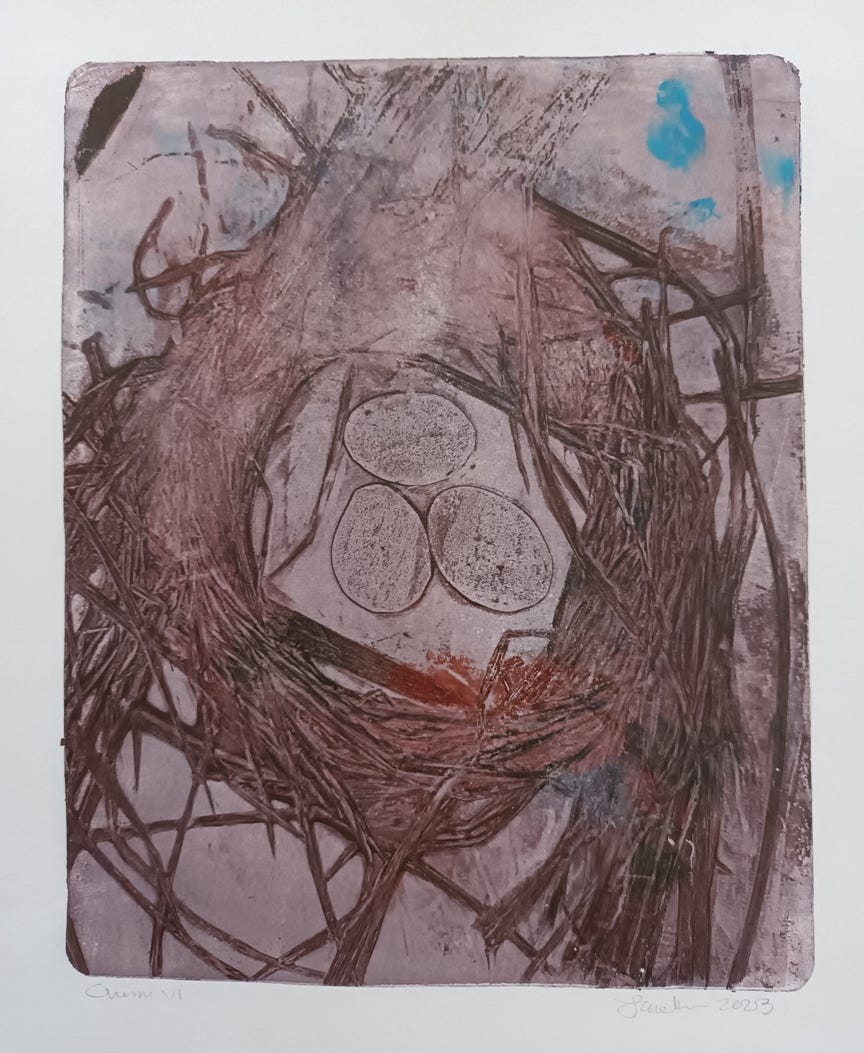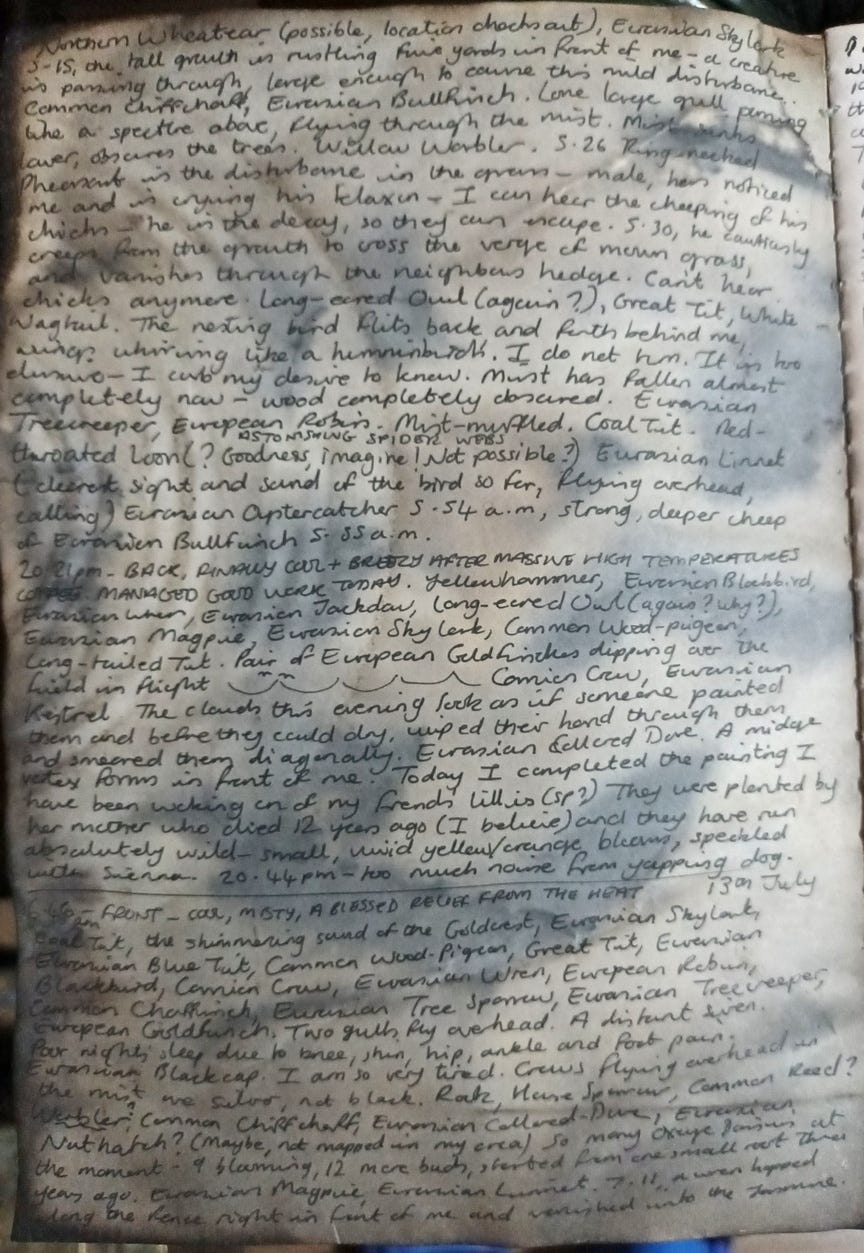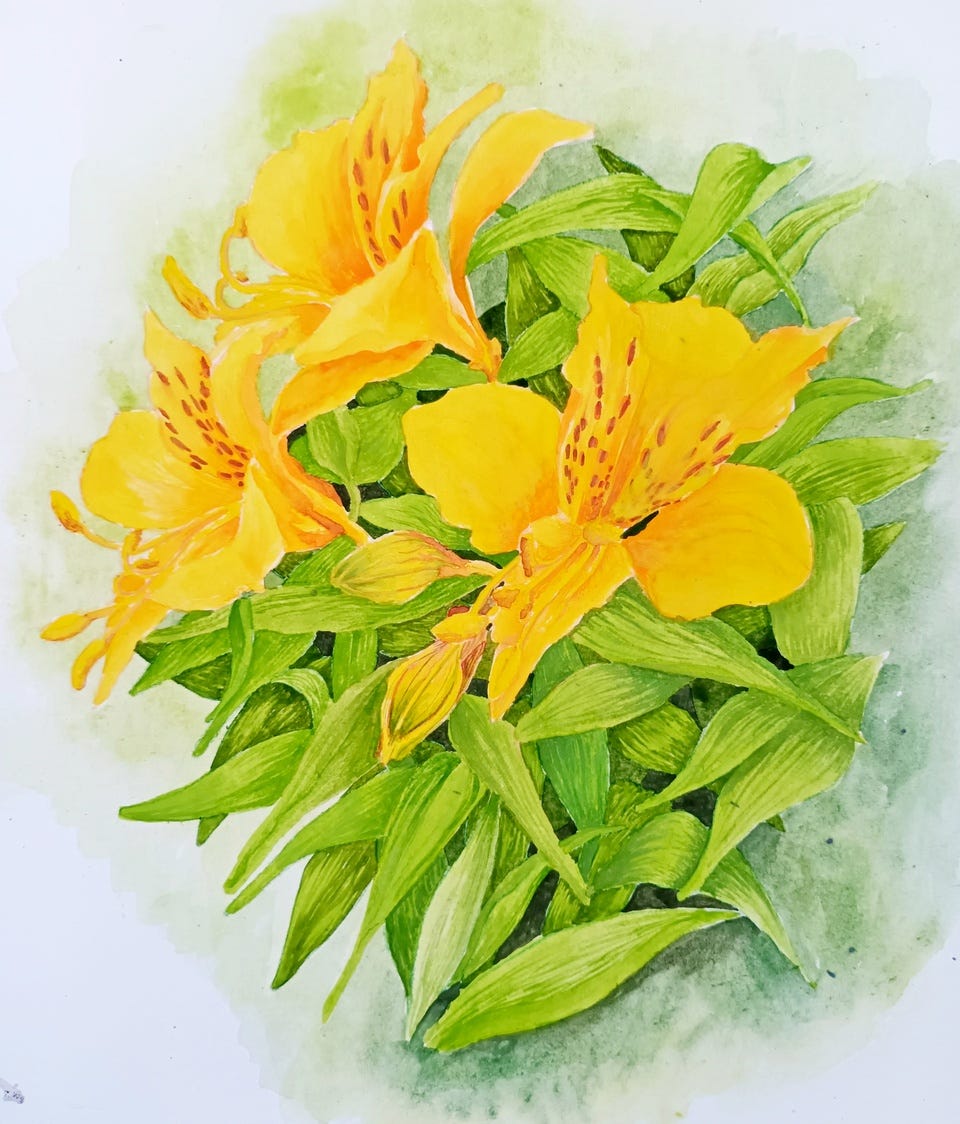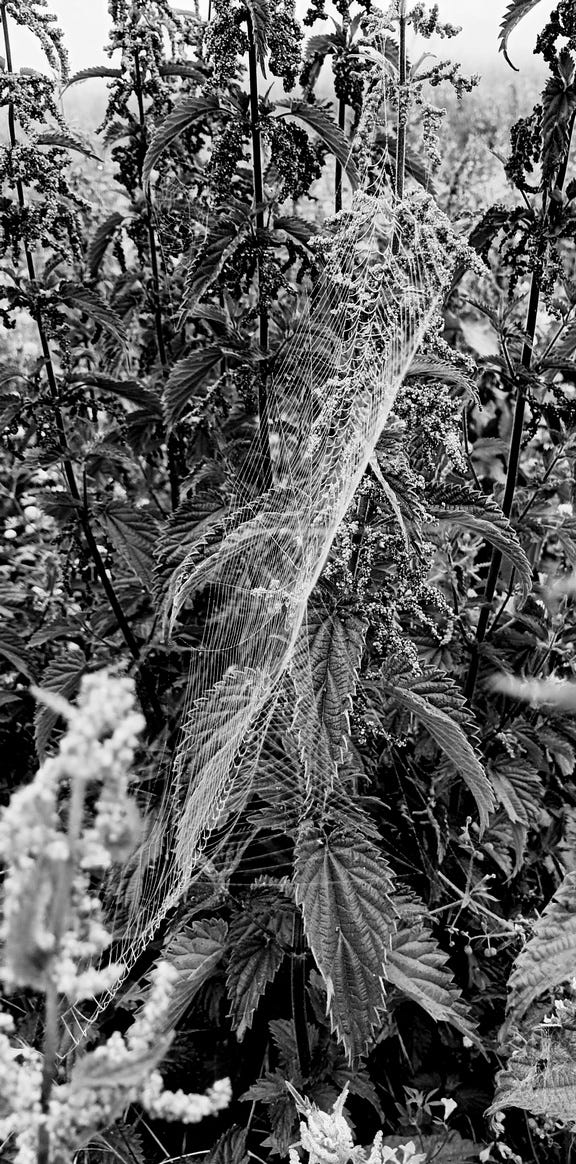The University of the Self #80
Birdsong, Botany and Betterness Part 10
Birdsong, Botany and Betterness Part 10

This article is a continuation of part 9, which can be found here.
Read article 11 here.
Content warning: this article mentions and has an image of a spider.

12th July continued……Northern Wheateater (possible, location checks out), Eurasian Skylark 5.15 p.m., the tall growth is rustling five yards in front of me – a creature is passing through large enough to cause this mild disturbance. Common Chiffchaff, Eurasian Bullfinch. Lone large gull passing like a spectre above, flying through the mist. Mist sinks lower, obscures the trees. Willow Warbler. 5.26 a.m. Ring-necked Pheasant is the disturbance in the grass – male, has noticed me and is crying his klaxon – I can hear the cheeping of his chicks – he is the decoy, so they can escape. 5.30 a.m., he cautiously creeps from the growth to cross the verge of mown grass, and vanishes through the neighbour’s hedge.
Can’t hear chicks anymore. Long-eared Owl (again?), Great Tit, White Wagtail. The nesting bird flits back and forth behind me, wings whirring like a hummingbird’s. I do not turn. It is too elusive – I curb my desire to know. Mist has fallen almost completely now – wood completely obscured. Eurasian Treecreeper, European Robin. Mist-muffled. Astonishing spider webs.
—————————————————————————————————
I began transcribing my diary entries for 12th July 2025 on 1st August, 2025 (it will take me a while to catch up, as it takes a lot of work).
The spider’s webs in the field on this day (12th July) were incredible. I do not know which species of spider had made them, or why there suddenly seemed to be so many. Was it mating season? An influx of food? Or was it just being in the right place at the right time? Was it the wonderful way the mist had settled the webs with its delicate beads? The early hour? A combination of all the above? Web after lacey, intricate, silvery web, strung between the nettles, thistles and wildflowers.
Here is one of the photographs I took of the webs. I turned the photo to monochrome in order to realise the web more clearly. It is attached to nettles. I was fascinated by this sideways view of the web and its brilliantly designed tensile structure. The web appears to be slightly concave, like a shallow dish. A radar, more efficient at gathering prey? For picking up the subtlest of signals? For aesthetic reasons – an individual spider’s signature shape? It’s silken fingerprint? Its architectural flair?
I traced the bridge thread, and the frame threads, each radius. The spider makes an auxiliary spiral from the centre which isn’t sticky, as a structural reference plan. Then it lays a sticky spiral and removes the auxiliary. The radius threads are not sticky, so that the spider can move around the web. The spider waits in the centre and when an insect lands on the web, it picks up the vibrations. The web is an incredible sensoryscape, spreading out from the spider, intensifying its world, guiding it, bringing it information. If the spider leaves the web, keeping hold of just one attached thread keeps it in contact with this extension of its inner self.
I thought that the back of the web was equally, if not more spectacular, as it was something I hadn’t noticed before, which is also why I chose this photograph. Behind the web’s front, toward the bottom is an amazing extra addition to the structure – a background support, the shape of a sail. What a feat of engineering it is.
In 2012, a shawl and cape made entirely from the silk of one million Golden Orb-weaver Spiders was displayed at the V&A Museum. It is too beautiful to be real. It is like looking into the heart of the sun, a life-filled yolk. I cannot believe it exists. Surely this garment is imbued with magical powers. It does not belong to our world. Its colour invaded my head – filled my veins with warm gold. I cannot imagine what it was like to encounter this cape and shawl in real life. It is too much for human eyes to bear. It aches with otherworldly beauty. I felt discomfited.
I looked further into the spider silk and its manufacture. Spiders have glands filled with liquid silk, which alters form when it comes into contact with the air. Liquid silk, like a pool of molten gold. We don’t need to imagine the existence of magic. Magic has been amongst us forever. Magic is this fluid sendal well, the spider’s living dwimmercraft, its alchemic transformation on emergence into thread, the becoming of the daedal web.
Content warning: mentions of abuse to spiders. I wanted to discover how spider silk is collected, and I was horrified to learn that the Golden Orb-weaver Spiders are restrained, before the stands of silk are pulled directly from their bodies and wound on reels. The spiders are conscious throughout. I was aghast. I thought of that shawl and cape made from this silk and became very upset.
Immediately after learning this, I had to shut down and went to bed (on 1st August), with the light turned off. I fell into a half-sleep, but remained powerfully aware of a huge, bright illuminated space in my head – the space was golden and burned brightly. The sensation would not abate. I lay like this for some hours before eventually falling asleep. This experience stayed with me all the next day (2nd August). What was it? Why did it happen? I had the strongest sense that it had been a vision of some kind. I cannot explain it any better than that. I do not know what the vision means. I felt as if the inside of my head had become the spider’s abdomen, filled with that liquid gold. I had somehow been allowed a glimpse inside. I will never forget it.
On 3rd August, I noticed a huge spider’s web close by the front door. The web had been constructed between the edge of a sideways-planted paving slab at the side of the doorsteps and an old terracotta chiminea with wrought iron legs which my husband found dumped at the side of the road (I have filled its centre with cobbles and shells and it is now a miniature insect environment), about three inches from the ground. The web was laid horizontally, instead of the more usual vertical. It was not a spiral-shaped web – it was more a random-seeming tangle of threads, laid many times so that it was very visible. In the centre was a huge spider, keeping very still.
The spider was approximately 5-6 cm, including its leg span. I carefully took a photograph. I looked up what species it might be and I think it was a Giant House Spider (Eratigena atrica), which can grow up to 12 cm. It is said that females can live for several years. The style of the webs they make are called ‘sheet webs’.
I was very much inspired to make a watercolour study of the spider from my photograph. This was a real challenge, as over the last few days I have been thinking about the human fear of spiders. I have found them frightening but have never killed them – I have always found careful ways to catch them and release them outside, and as I get older and learn more about them and their habits, I try to live with the ones I see in my home. I am not entirely comfortable with them, no matter how hard I try. I began to wonder if the fear of them is human instinct or learned behaviour, or a bit of both? After all, spiders are a go-to horror story device. I wasn’t sure I would be able to paint the spider as it would mean very close study. I took a little time to look, then began to zoom in on areas of the spider. It wasn’t an easy process but I stuck to it and worked to see the many intricate beauties of the spider – its amazing markings, the jointed legs, the miniscule hairs. Here is the result:

Next time I feel afraid of spiders, I am going to remember the lakes of liquid silk inside them; their amazingly engineered webs; the fact that some can live for years; their floating babies. And if this does not work, I am going to remember that they have respiratory organs inside them called ‘book lungs’ made from stacked layers which resemble the pages of a book. So they breathe through books – they need books to live, as we do. So, we have something amazing in common – books can be the air we breathe. What a wonderful thought.
——————————————————————————————————
Red-throated Loon(? Goodness, imagine! Not possible?), Eurasian Linnet (clearest sight and sound of the bird so far, flying overhead, calling), Eurasian Oysercatcher 5.54 a.m. Strong deeper cheep of Eurasian Bullfinch 5.55 a.m.
20.21 p.m. Back. Finally cool and breezy after massive high temperatures. Coffee. Managed good work today.
Yellowhammer, Eurasian Blackbird, Eurasian Wren, Eurasian Jackdaw, Long-eared Owl (again? Why?), Eurasian Magpie, Eurasian Skylark, Common Wood Pigeon, Long-tailed Tit. Pair of European Goldfinches dipping over the field in flight (here I have drawn a line of swooping, mile shaped lines to represent their flight, and I have also drawn two little bird shapes). Carrion Crow, Eurasian Kestrel.
The clouds this evening look as if someone painted them and before they could dry, wiped their hand through them and smeared them diagonally.
Eurasian Collared Dove.
A midge vortex forms in front of me. Today I completed the painting I have been working on of my friend’s lilies. They were planted by her mother who died 12 years ago (I believe) and they have run absolutely wild – small, vivid yellow/ orange blooms, speckled with sienna. 20.44 p.m. too much noise from yapping dog.
Here is a watercolour painting I made of my friend’s lilies.

13th July 6.46 a.m. Front. Cool, misty, a blessed relief from the heat.
Coal Tit, the shimmering sound of the Goldcrest, Eurasian Skylark, Eurasian Blue Tit, Common Wood Pigeon, Great Tit, Eurasian Blackbird, Carrion Crow, Eurasian Wren, European Robin, Common Chaffinch, Eurasian Tree Sparrow, Eurasian Treecreeper, European Goldfinch. Two Gulls fly overhead.
A distant siren. Poor night’s sleep due to knee, shin, hip, ankle and foot pain. Eurasian Blackcap. I am so very tired. Crows flying overhead in the mist are silver, not black.
Rook, House Sparrow, Common Reed Warbler ?, Common Chiffchaff, Eurasian Collared Dove, Eurasian Nuthatch ? (Maybe, not mapped in my area)
So many Oxeye Daisies at the moment – 9 blooming, 12 more buds, started from one small root three years ago.
Eurasian Magpie, Eurasian Linnet. 7.11 a.m. a wren hopped along the fence right in front of me and vanished into the jasmine.
———————————————————————————————————
Please consider helping me to keep on sharing my articles with you…
I hope you enjoyed reading my latest article. Thank you so much for spending some time here with me. Times are tough, but if you feel like supporting a struggling writer so that she can continue being able to write, (every tiny bit helps) you can do so below…
I have currently left my Substack free, but if anyone should feel like sending me a tip (although there is no pressure to do so) in exchange for my tips, you can ‘buy me a coffee’ here . Every little bit makes a big difference. Or please do subscribe, which you can do either as paid or free. Either will let you see my articles. Many thanks.
If you like the article you have read, please do click the like button — I’d love to know you are out there.
I must add the usual disclaimer here: I am not sponsored or paid by any of the websites I link to (I do this in an attempt to help others find information, and I may or may not agree/disagree with any/some of the content) — sharing does not immediately equal endorsment. I also hope I haven’t written anyting that might offend anyone. I try very hard to be as considerate and kind as possible.


